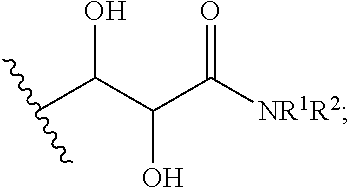Heteroaryl compounds as sodium channel blockers
a technology of sodium channel blocker and heteroaryl compound, which is applied in the field of new heteroaryl compound, can solve the problems of many undesirable side effects of the currently available treatmen
- Summary
- Abstract
- Description
- Claims
- Application Information
AI Technical Summary
Benefits of technology
Problems solved by technology
Method used
Image
Examples
example 1
(2R,3S)-2,3-Dihydroxy-3-(1-(4-((5-(trifluoromethyl)pyridin-2-yl)oxy)phenyl)-1H-indol-3-yl)propanamide (5)
[0364]
[0365](a) (E)-Ethyl 3-(1-(4-((5-(trifluoromethyl)pyridin-2-yl)oxy)phenyl)-1H-indol-3-yl)acrylate (3) was prepared as follows: A mixture of compound 1 (Alfe Aesar, 0.5 g, 1.0 eq), compound 2, CuI (0.2 eq), K2CO3 (3 eq), and dimethylglycine (Aldrich, 0.1 eq) in DMF (10 mL) was heated at 160° C. for 30 minutes under microwave. The mixture was dissolved in water / EtOAc (20 mL / 100 mL). The organic layer was washed with brine, concentrated and purified by column (silica gel, EtOAc / hexane 1 / 10) to afford compound 3 as a white solid (0.4 g, 40%): 1H-NMR (400 MHz, CDCl3) δ: 8.42 (s, 1H), 7.85-7.92 (m, 3H), 7.54 (s, 1H), 7.47-7.51 (m, 3H), 7.23-7.29 (m, 4H), 7.06 (d, 1H, 8.8 Hz), 6.45 (d, 1H, 16 Hz), 4.23 (q, 2H, 7.1 Hz), 1.29 (t, 3H, 7.2 Hz).
[0366](b) 2-(4-Bromophenoxy)-5-(trifluoromethyl)pyridine (2) was prepared by heating a mixture of 4-bromophenol (1.0 eq, Aldrich), 2-chloro-5-(t...
example 2
(2S,3R)-Ethyl 2,3-dihydroxy-3-(1-(4-((5-(trifluoromethyl)pyridin-2-yl)oxy)phenyl)-1H-indol-3-yl)propanoate (6)
(2S,3R)-2,3-Dihydroxy-N-methyl-3-(1-(4-((5-(trifluoromethyl)pyridin-2-yl)oxy)phenyl)-1H-indol-3-yl)propanamide (7)
(2S,3R)-2,3-Dihydroxy-3-(1-(4-((5-(trifluoromethyl)pyridin-2-yl)oxy)phenyl)-1H-indol-3-yl)propanamide (8)
[0369]
[0370](a) Compound 6 was prepared according the same procedure described in Example 1 for preparing compound 4 using Ad-mix-β (Aldrich) as a starting material. Compound 6 was obtained as a yellow solid (70%): 1H-NMR (400 MHz, CD3OD): δ 8.37 (s, 1H), 8.04 (1H, dd, 2.6 & 8.6 Hz), 7.64 (1H, d, 7.8 Hz), 7.43-7.51 (m, 4H), 7.25-7.28 (m, 2H), 7.04-7.14 (m, 3H), 5.03 (dd, 1H, 0.6 & 4.6 Hz), 4.41 (d, 1H, 4.6 Hz), 4.0 (q, 2H, 7.0 Hz), 1.01 (t, 3H, 7.0 Hz); LC / MS: m / z=507.1 [M+Na+](Calc: 486.4).
[0371](b) Compound 7 was prepared following the same procedure described in Example I for preparing compound 5 using MeNH2 (33% in EtOH, 4 eq, Aldrich) as a starting materi...
example 3
(2S,3R)-Ethyl 3-(6-(4-(3-cyano-4-(trifluoromethyl)phenoxy)phenyl)pyridin-2-yl)-2,3-dihydroxypropanoate (14)
(2S,3R)-3-(6-(4-(3-Cyano-4-(trifluoromethyl)phenoxy)phenyl)pyridin-2-yl)-2,3-dihydroxypropanamide (15)
[0373]
[0374](a) (E)-Ethyl 3-(6-bromopyridin-2-yl)acrylate (11) was prepared as follows: A solution of compound 9 (7 g, 37 mmol, Aldrich) in 80 mL of THF was added drop-wise under argon to a mixture of compound 10 (46 mmol, Aldrich) and NaH (60% in mineral oil, 65 mmol, Aldrich) in 200 mL of THF at room temperature over 1 hour. The resulting solution was stirred at room temperature for 14 hours. The reaction mixture was cooled with ice-water, slowly quenched with water (40 mL), and extracted with EtOAc. The organic layer was washed with brine, concentrated, and purified by column (silica gel, EtOAc / Hexanes 5 / 1) to get compound 11 as a white solid (7 g): 1H-NMR (400 MHz, CDCl3) δ 7.56-7.61 (m, 2H), 7.46 (dd, 1H, 0.87 & 7.89 Hz), 7.37 (dd, 1H, 0.6 & 7.5 Hz), 6.97 (d, 1H, 15.8 Hz),...
PUM
| Property | Measurement | Unit |
|---|---|---|
| temperatures | aaaaa | aaaaa |
| pH | aaaaa | aaaaa |
| pH | aaaaa | aaaaa |
Abstract
Description
Claims
Application Information
 Login to View More
Login to View More - R&D
- Intellectual Property
- Life Sciences
- Materials
- Tech Scout
- Unparalleled Data Quality
- Higher Quality Content
- 60% Fewer Hallucinations
Browse by: Latest US Patents, China's latest patents, Technical Efficacy Thesaurus, Application Domain, Technology Topic, Popular Technical Reports.
© 2025 PatSnap. All rights reserved.Legal|Privacy policy|Modern Slavery Act Transparency Statement|Sitemap|About US| Contact US: help@patsnap.com



